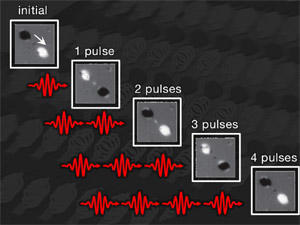Laser Heat Used to Make HDD Write Transfers Faster
Researchers have discovered that recording data on a HDD platter using a quick laser burst is much faster than the traditional use of a magnetic field.
Researchers at the University of York's Department of Physics have discovered a way to record data on an old-school mechanical hard drive without using a magnetic field. Instead, they used laser heating which processes information much faster on a magnetic medium (platter in this case) than current means used in today's drives. This discovery should not only make future magnetic recording devices perform much faster, but also more energy efficient.
"This revolutionary method allows the recording of Terabytes (thousands of Gigabytes) of information per second, hundreds of times faster than present hard drive technology," said York physicist Thomas Ostler in a paper published in the February edition of the Nature Communications journal. "As there is no need for a magnetic field, there is also less energy consumption."
In the paper, Ostler describes a system that uses a sub-picosecond laser pulse to quickly heat the magnetic medium to around 800 degrees Celsius for a brief moment. This heating significantly speeds up the process of reversing the magnetic polarity of a particular bit. Current hard drives use an external magnetic field applied to a spinning magnetic medium to invert the polarity of the two magnetic poles.
An experimental image supplied to Science Daily shows two nano islands that have different magnetic orientations. After the islands are hit with a single laser pulse, the magnetic direction of both islands changes. By the fourth pulse, they've returned to their initial state.
"For centuries it has been believed that heat can only destroy the magnetic order," said Dr. Alexey Kimel, from the Institute of Molecules and Materials, Radboud University Nijmegen. "Now we have successfully demonstrated that it can, in fact, be a sufficient stimulus for recording information on a magnetic medium."
The team of scientists behind the discovery include researchers from Spain, Switzerland, Ukraine, Russia, Japan and the Netherlands. The experimental work was conducted at the Paul Scherrer Institut in Switzerland, the Ioffe Physical Technical Institute of the Russian Academy of Sciences and Radboud University Nijmegen, Netherlands.
Get Tom's Hardware's best news and in-depth reviews, straight to your inbox.

Kevin Parrish has over a decade of experience as a writer, editor, and product tester. His work focused on computer hardware, networking equipment, smartphones, tablets, gaming consoles, and other internet-connected devices. His work has appeared in Tom's Hardware, Tom's Guide, Maximum PC, Digital Trends, Android Authority, How-To Geek, Lifewire, and others.

